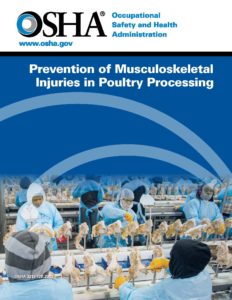Things to Remember
Musculoskeletal injuries are a significant concern in the poultry processing industry, where workers engage in repetitive tasks and often work in awkward positions. These injuries can lead to chronic pain, reduced productivity, and increased healthcare costs. To ensure a safe working environment and promote the well-being of employees, it is crucial to implement preventive measures. In this article, we will explore effective strategies and best practices to preventing injuries in poultry processing facilities.
1. Ergonomic Workstations and Equipment:
One of the primary contributors to musculoskeletal injuries is poor workstation design. Employers must invest in ergonomically designed workstations and equipment to minimize strain on workers’ bodies. Adjustable work surfaces, height-adjustable chairs, and appropriate lighting are essential elements in creating ergonomic workstations. Additionally, using mechanized tools and equipment for tasks such as lifting, cutting, and deboning can significantly reduce the risk of injuries.
2. Training and Education:
Proper training and education play a crucial role in preventing musculoskeletal injuries. Employees should receive comprehensive training on ergonomic techniques, safe work practices, and the proper use of equipment. Regular refresher courses can help reinforce these practices and keep workers updated on the latest safety guidelines. Training programs should also include information on identifying early signs of musculoskeletal discomfort and the importance of reporting symptoms promptly.
3. Job Rotation and Breaks:
Repetitive motions and prolonged periods of static posture can lead to muscle fatigue and increased injury risk. Implementing job rotation and scheduled breaks can help reduce the strain on specific muscle groups and provide opportunities for recovery. By alternating tasks or allowing employees to switch between workstations periodically, workers can avoid overexertion and minimize the risk of developing musculoskeletal injuries.
4. Stretching and Warm-Up Exercises:
Encouraging employees to perform stretching and warm-up exercises before starting their shifts can significantly improve flexibility, reduce muscle tension, and prevent injuries. Simple exercises, such as neck rotations, shoulder stretches, and wrist flexion/extension, can help warm up the muscles and joints. Employers can conduct regular group stretching sessions or provide educational materials on recommended exercises to foster a culture of proactive injury prevention.
5. Adequate Staffing and Workload Management:
Understaffing and excessive workloads can contribute to hurried work and improper lifting techniques, increasing the likelihood of musculoskeletal injuries. Employers must ensure adequate staffing levels to manage workloads effectively. Regular reviews of workload distribution and the provision of additional resources during peak periods are essential to maintaining a manageable and safe work environment.
6. Continuous Improvement and Feedback:
Creating a culture of continuous improvement and open communication is vital for preventing musculoskeletal injuries. Employers should actively seek feedback from workers regarding potential hazards, discomfort, and suggestions for improvement. Regular safety audits and ergonomic assessments can help identify areas that require attention. This, in turn, allows for timely modifications to workstations, equipment, or procedures.
Conclusion:
Preventing musculoskeletal injuries in poultry processing requires a comprehensive approach that addresses ergonomic design, training, job rotation, breaks, stretching exercises, adequate staffing, and continuous improvement. By implementing these strategies, employers can create a safer work environment, reduce the risk of injuries, and promote the well-being of their workforce. Investing in injury prevention not only protects the employees but also contributes to enhanced productivity, reduced healthcare costs, and a positive workplace culture. By prioritizing the prevention of musculoskeletal injuries, the poultry processing industry can pave the way for healthier and more sustainable operations.
Contact us today and let us help you to improve your employee’s health and reduce work-related injuries.
Related article:
Ergonomic Solutions for Retailers (NIOSH)
- Material handling injuries can have a significant impact on the productivity and well-being of workers in the retail sector. With the physical demands of lifting, carrying, and moving heavy items, it is crucial to implement effective injury prevention measures. This article aims to provide ergonomic solutions for retailers on preventing material handling injuries, highlighting key strategies and best practices.
- Before diving into ergonomic solutions for retailers, it’s essential to understand the common risks associated with material handling in retail stores. These risks include musculoskeletal disorders, strains, sprains, slips, trips, and falls. By recognizing these hazards, employers can take proactive steps to address them effectively.

